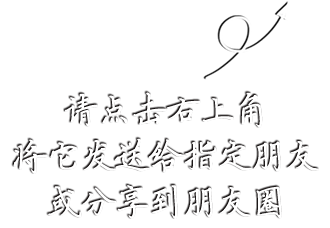
Online Scan the QR code to watch the video.

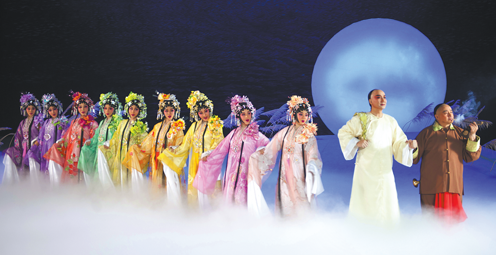
A scene from the Cantonese Opera production Hua Yue Ying (Shadow of Flower and Moon), featuring actor Li Junsheng (second from right).
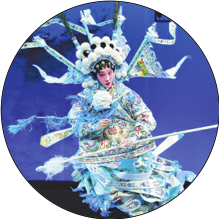
Li Jiayi plays the title role in Mu Guiying.
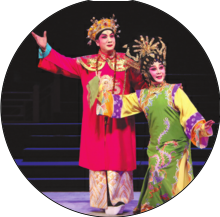
Li Junsheng plays the lead role in Prince Rui and His Concubine.
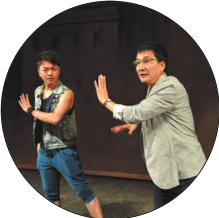
Li Junsheng is committed to coaching his student.
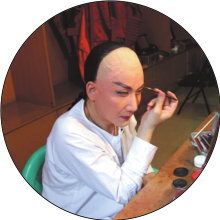
Li Junsheng applies makeup before a performance.
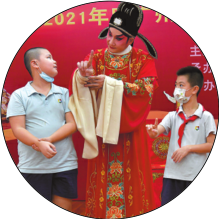
Li Junsheng demonstrates the basic hand gestures for children in Guangzhou, Guangdong province.
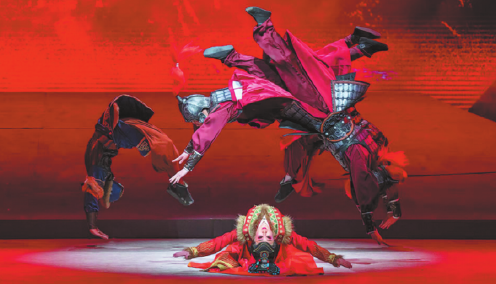
A scene from Princess Wencheng, a Cantonese Opera production which earned Li Jiayi the 31st Chinese Drama Plum Blossom Award in 2023.
In a small theater in Maoming city in South China's Guangdong province, Cantonese Opera echoes through the air, the rhythmic beat of drums, the melodic instruments and the soaring voices of performers filling the atmosphere with life and energy. This was the world Li Junsheng was born into.
Li's parents were both professional Cantonese Opera actors, and he grew up immersed in the art form. The stage was not a distant dream — it was part of his everyday life.
As a child, Li often sat in the family courtyard, watching his parents practice and rehearse. While his peers played outside, he absorbed the intricacies of Cantonese Opera — the physical movements, operatic melodies and nuanced expressions.
"Cantonese Opera is more than just a performance to me; it's a legacy passed down through generations," says Li, now 60.
One of the most important and influential forms of traditional Chinese opera, Cantonese Opera originated from the Cantonese-speaking regions of southern China, particularly Guangdong province, Hong Kong and Macao. It combines song, dance, acting and martial arts to tell stories through intricate performances that reflect local culture, history and folklore.
In 2009, Cantonese Opera was inscribed on UNESCO Representative List of the Intangible Cultural Heritage of Humanity, recognizing its significance and role in preserving the rich traditions of southern China.
President Xi Jinping paid a visit to the Cantonese Opera Art Museum during his inspection in Guangzhou, Guangdong province, in 2018. He encouraged local enthusiasts to continue preserving and promoting the opera for future generations.
His words were a reaffirmation of the national commitment to safeguarding China's cultural heritage, with Cantonese Opera standing as one of its shining jewels.
Perseverance pays off
Li is one of the local performers who have devoted themselves to keeping this art form thriving onstage.
At 7, Li began formal training, where early mornings were spent doing rigorous exercises — stretching, leg splits and handstands — instilling in him that performing requires more than talent.
"It requires absolute dedication," he says.
By 12, Li made his stage debut. At 16, he joined a local troupe in Maoming, feeling the exhilaration of performing before live audiences, and taking in the applause and the energy of the crowd.
The 1980s marked a period of significant cultural and economic changes in China after the reform and opening-up started in 1978.
Urbanization, Western influences and the rise of television led to a decline in traditional Chinese opera's popularity. Opera troupes closed, and younger generations gravitated toward modern entertainment. Despite this, Li didn't give up.
"There were times I thought about changing careers because of the low pay and physical exhaustion. Many colleagues left the troupe but I couldn't," he says.
Li's perseverance paid off. In the early 1990s, he moved to Guangzhou, a city with a rich Cantonese Opera tradition and modernization. He was recruited by the legendary Hung Sin-nui, a foremost figure in the world of Cantonese Opera, to join her prestigious troupe.
Guangzhou's openness to Western influences and the government's growing support for traditional arts created an environment where Li could thrive.
In 2001, Li joined the Guangzhou Cantonese Opera Theatre and starred in many classic productions. One of his signature roles was as Lin Yuansheng in Hua Yue Ying (Shadow of Flower and Moon). The role earned him the 25th Chinese Drama Plum Blossom Award in 2011, the country's highest honor in theater.
However, Hua Yue Ying was controversial for its fusion of modern elements, including symphonic music and pop dance. Some traditionalists rejected these innovations, but Li says: "The production preserves the essence of Cantonese Opera; we just used contemporary techniques in how we present it."
Over time, audiences accepted the new approach, and the arias from the production became popular, even appearing on karaoke apps.
Li's work wasn't just on the stage. The production was adapted into a film, blending Cantonese Opera with cinematic techniques, allowing the art form to reach younger audiences who might not otherwise have been exposed to it.
Li Jiayi, another star in the Cantonese Opera world, took a different path into the art form. Unlike Li Junsheng, she wasn't born into a family of opera performers but grew up in a household filled with Cantonese Opera enthusiasts.
Hailing from Zhongshan, Guangdong province, where Cantonese Opera was a community cornerstone, Li Jiayi recalls being fascinated by the art from a young age.
"I was drawn to the beautiful costumes, the singing style and the grace of the performances," she says. In her hometown, local opera troupes performed regularly, and private singing groups held weekly events.
At just 7, Li Jiayi sang in front of a live band for the first time. The audience was impressed by her accuracy in rhythm, tone and phrasing.
"Cantonese Opera songs subtly nurtured my artistic growth," she says.
Process of transformation
Li Jiayi's passion led her to participate in a national Cantonese Opera singing competition in 1999, where she won first place. In Beijing, during the awards ceremony, she met a teacher from the Guangdong Cantonese Opera School, sparking her formal training.
Li Jiayi quickly learned that performing Cantonese Opera was no easy task.
"One minute onstage comes from more than 10 years of practice," she says. She trained to become a daomadan, a martial, heroic female role in Cantonese Opera known for its action and acrobatics.
"Traditional Chinese opera is a comprehensive art. You must master singing, acting, recitation and acrobatics," she adds.
Her rigorous training at a local Cantonese Opera school lasted six years. When she graduated, she joined the Guangdong Cantonese Opera Institute.
During her early years there, she was called upon to replace a leading actress who had fallen ill. Stepping in at the last minute, Li Jiayi flawlessly performed the role, impressing the theater and earning her more opportunities.
In 2018, Li Jiayi joined the Guangzhou Cantonese Opera Theatre. Over the years, she portrayed many female characters.
"It's a process of creation and transformation," she says.
Her portrayal of Princess Wencheng earned her the 31st Chinese Drama Plum Blossom Award in 2023.
Princess Wencheng of the Tang Dynasty (618-907) embarked on a journey from Chang'an (Xi'an, Shaanxi province) to wed Tubo ruler Songtsen Gampo, as a marriage alliance. This role demanded Li Jiayi to embody a character evolving through four decades — from youthful innocence to wisdom gained through hardship.
"It's very challenging. … I will never forget the days I spent in the rehearsal room along with my colleagues," she says.
Now, at 36, Li Jiayi is the vice-president of Guangzhou Red Bean Cantonese Opera Troupe of the theater. Besides performing, she is committed to innovating Cantonese Opera to make it more relevant to younger audiences.
She launched an album combining Cantonese Opera with pop and electronic music and collaborated with Tencent to incorporate Cantonese Opera movements into video games.
"The fusion of modern technology with traditional art creates endless possibilities for innovation," she says.
"Cantonese Opera deserves to be seen by more people, especially younger audiences. Reinterpreting it through creative adaptations makes it easier for them to connect with their cultural heritage."
Contact the writer at chennan@chinadaily.com.cn

